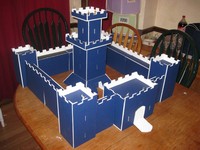 Notes on my Castle Design
Notes on my Castle Design
 Notes on my Castle Design
Notes on my Castle Design
My designs aim to be cheap, strong, and easy to build as well as modular - that is, pieces can be assembled in various arrangements to create different castles and still work together well. So far I have the following modular pieces:
Angled bases are used where possible, but since they are harder to construct I limit them to the keep or other heavily fortified position. In the future I may modify the standard wall design to have a standard slanted base, but most castles did not have this so it doesn't seem necessary.
Concentric wall designs will require higher wall sections and towers to be constructed for the inner bailey. This may be 10" = 50' high for the walls and 13" = 65' high for the towers.
Just to see what other folks are doing, check out this guy's site! I don't think I'm going to go quite this far, but it's cool to see what other people are doing and compare notes. Great work.
Notes on Historical Castle Design
 The defenses for the castle consisted of many things, from the moat to battlements. As castle design advanced, so too did the defenses. An allure was the wall-walk along the top of a curtain wall. They were accessed by a wooden or stone stair parallel to the wall, or sometimes by a mural tower. Wall-walks were often paved with stone slabs. A later 13th century innovation was an overhanging allure. This developed into flying parapets and machicolations.
The defenses for the castle consisted of many things, from the moat to battlements. As castle design advanced, so too did the defenses. An allure was the wall-walk along the top of a curtain wall. They were accessed by a wooden or stone stair parallel to the wall, or sometimes by a mural tower. Wall-walks were often paved with stone slabs. A later 13th century innovation was an overhanging allure. This developed into flying parapets and machicolations.
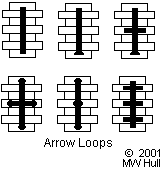 Arrow loops, also known as arrow slits or bow loops, allowed defenders to fire their arrows from cover. There were several different styles, as illustrated below. Rare before 1190, they were normally just a simple vertical slot, less than two inches wide at the outside, and averaged between 3 to 12 feet in length.
Arrow loops, also known as arrow slits or bow loops, allowed defenders to fire their arrows from cover. There were several different styles, as illustrated below. Rare before 1190, they were normally just a simple vertical slot, less than two inches wide at the outside, and averaged between 3 to 12 feet in length.
In the late 12th century, developments included the introduction of a splayed foot, which formed a wider part in the slot and allowed soldiers to aim over a larger area outside the castle beneath them. At the same time, horizontal slits were introduced.
During the 13th century, the ends of the slits often became rounded, and were known as oillets. In addition, more than one cross-arm came into use. Some arrow loops were massive (e.g., up to 17 feet long, with triple cross-arms).
 The barbican was a exterior defense protecting the entrance of the castle. It confined an approaching enemy to a narrow front, often leaving the attackers in the open, and offered an easy target for the castle defenders. Barbicans also confused the attackers, as they oftentimes found themselves in a hopeless maze of twists and turns. The most common type is a walled passage projecting from the front of the gatehouse.
The barbican was a exterior defense protecting the entrance of the castle. It confined an approaching enemy to a narrow front, often leaving the attackers in the open, and offered an easy target for the castle defenders. Barbicans also confused the attackers, as they oftentimes found themselves in a hopeless maze of twists and turns. The most common type is a walled passage projecting from the front of the gatehouse.
 A small turret or lookout projecting out at an angle of a tower or on the surface of a wall and supported by corbels was called the bartizan. Also referred to as a crow's nest, the bartizan was almost always located at one of the highest points of the castle. The bastion was a prominent projection meant to cover dead ground, flank curtains and provide crossfire. Dead ground means an area where attackers could not be seen or fired upon, a blind spot.
A small turret or lookout projecting out at an angle of a tower or on the surface of a wall and supported by corbels was called the bartizan. Also referred to as a crow's nest, the bartizan was almost always located at one of the highest points of the castle. The bastion was a prominent projection meant to cover dead ground, flank curtains and provide crossfire. Dead ground means an area where attackers could not be seen or fired upon, a blind spot.
A batter, plinth or spur is the angled footing of a wall or tower. It was used to counter undermining or to cause dropped missiles to ricochet horizontally. This defensive invention also acted as a deflecting surface for battering rams, thus making them less effective.
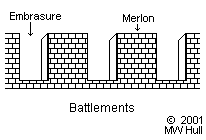 The battlements, or crenellations, provided a walk on the wall summit, a fighting platform and a defense against escalade (scaling the walls). They are also the distinguishing feature of a castle. An embrasure, or crenel, is a splayed opening in a wall used to provide a firing point. They were usually from 2-3 feet wide, while the intervening merlons rose 3-7 feet high and were about 5 feet wide. Often these crenels would have wooden shutters for greater protection. Sometimes battlements were used symbolically on unfortified structures to give the impression that the buildings were true castles. Merlons are the solid parts of a crenellated parapet. They were sometimes pierced with arrow slits.
The battlements, or crenellations, provided a walk on the wall summit, a fighting platform and a defense against escalade (scaling the walls). They are also the distinguishing feature of a castle. An embrasure, or crenel, is a splayed opening in a wall used to provide a firing point. They were usually from 2-3 feet wide, while the intervening merlons rose 3-7 feet high and were about 5 feet wide. Often these crenels would have wooden shutters for greater protection. Sometimes battlements were used symbolically on unfortified structures to give the impression that the buildings were true castles. Merlons are the solid parts of a crenellated parapet. They were sometimes pierced with arrow slits.
The level area or space between the castle curtain wall and the ditch or moat is called the berm. The braie is an exterior defense of small height hindering an attacker's approach; it was most commonly made of earth. A cross wall is an interior or exterior dividing wall. Some went across the bailey and others divided the keep or other structures. The curtain wall surrounded the bailey or castle buildings. It was often connected by flanking towers and could be from 6-20 feet thick. Sometimes arrow slits were placed in the curtain wall so that the castle defenders could safely shoot at the attackers.
A drawbridge was a moveable wooden bridge that gapped the castle ditch or moat. It could be removed or raised to prevent easy entry into the castle. The gatehouse was the entrance to the castle containing at least one portcullis that could be raised or lowered. Vaulted ceilings could contain murder holes and arrow slits in the side walls.
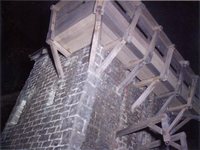 Hoarding, or brattice, was developed to cover dead ground, or blind spots at the base, or foot, of the curtain wall. A covered wooden gallery positioned in front of the battlements with holes in the floor, the hoard allowed defenders to observe and fire upon attackers. In the later Middle Ages, hoarding evolved into stone machicolations. Sometimes machicolations were used symbolically to recreate a castellated effect on unfortified structures.
Hoarding, or brattice, was developed to cover dead ground, or blind spots at the base, or foot, of the curtain wall. A covered wooden gallery positioned in front of the battlements with holes in the floor, the hoard allowed defenders to observe and fire upon attackers. In the later Middle Ages, hoarding evolved into stone machicolations. Sometimes machicolations were used symbolically to recreate a castellated effect on unfortified structures.
The keep, great tower, or donjon was a self-sufficient, last resort, place of refuge used during a siege. Most keeps were square or rectangular in shape, although there were round keeps. Some keeps were over 80 feet high and had walls over 17 feet thick.
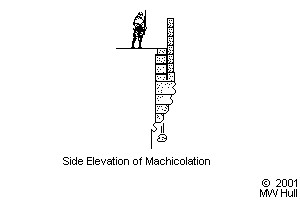 Machicolations were openings in the floor of a projecting parapet or platform along the wall or above an archway, through which defenders could drop or shoot missiles vertically on attackers below.
Machicolations were openings in the floor of a projecting parapet or platform along the wall or above an archway, through which defenders could drop or shoot missiles vertically on attackers below.
Moats were kept full by a nearby water supply: a spring, lake, stream, or river. The builders would put a dam on the outlet side of the water supply, and control the water level in the moat. Some moats had stone casings, but most were left with earthen banks. Most castles, however, had dry moats, known simply as ditches.
The purpose of water defenses was to prevent the castle from being besieged. Sappers found it difficult to tunnel under a moat; attackers could not wade across, for fear of drowning in the deep waters; attackers would not dare swim across the moat, as it presented too big of a target for the castle guards and made them very vulnerable. Attackers were known to use portable bridges, or barges, to span the moat and besiege a castle.
There is a myth that alligators or crocodiles were placed in the moats. This is not true. Some moats did have eels and other kinds of fish in them for food. Sometimes, sharpened sticks (bungy sticks) were placed in the moat to prevent attackers from safely entering it. Burning liquids may also have been poured in the moats, but references to this are not proven.
Some castles, like Caerphilly Castle in Wales, sit in the middle of artificial lakes, but most had simple moats. Some moats only surrounded parts of the castle. Sometimes, water defenses were used along with other natural defenses, such as a cliff or river. Moats often ranged between 3 and 30 feet in depth, and were typically well over 12 feet in width. They reached the peak of their development in the 13th century, and went out of fashion in the late 16th century.
Murder holes are openings in a floor through which the castle defenders could drop missles or liquids upon the attackers. Stones were the most often used missile. Boiling oil was not used, as it was a precious commodity to waste. More than likely, if any boiling liquid was used, it was water. Murder holes were most often located in the vaulting over the gate passage. The parapet was an embattled wall shielding the castle defenders on the wall-walk.
Almost all stone castles had towers. Some were flanking towers in the curtain wall, gatehouse towers, smaller stair, or mural towers. Towers provided access to the wall walks, lookout points and sleeping quarters for the castle garrison. Towers could be square, D-shaped, or round. They were important defensive features, as were the other ones mentioned above.
Credits / Sources: